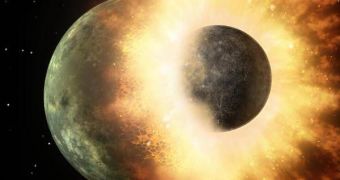The Spitzer Infrared Space Telescope has recently discovered the heat signatures of a massive impact event that took place within the last thousands of years around a young star. Two large bodies, one at least the size of the Moon, and the other probably as large as Mercury, collided into each other, and the clash resulted in the vaporization of the smaller one. Plumes of lava and vaporized rock were thrown into outer space following the impact, and researchers believe this phenomenon may be crucial for our understanding of how Earth-like planets form.
They also believe that the impact may have taken place at an incredibly high speed, as vast amounts of energy would have been required for one of them to be totally vaporized. “This collision had to be huge and incredibly high-speed for rock to have been vaporized and melted, This is a really rare and short-lived event, critical in the formation of Earth-like planets and moons. We're lucky to have witnessed one not long after it happened,” says Johns Hopkins University expert Carey M. Lisse.
The scientist works at the Laurel, MD-based University's Applied Physics Laboratory, and is also the lead author of a new scientific paper detailing the observations, to be published in the August 20th issue of the respected Astrophysical Journal. The telescope was able to pick up the heat signatures generated by the ejected lava, and by the refrozen rocks, called tektites, ScienceDaily informs.
“The collision that formed our moon would have been tremendous, enough to melt the surface of Earth. Debris from the collision most likely settled into a disk around Earth that eventually coalesced to make the moon. This is about the same scale of impact we're seeing with Spitzer – we don't know if a moon will form or not, but we know a large rocky body's surface was red hot, warped and melted,” states NASA Jet Propulsion Laboratory (JPL) expert Geoff Bryden, who is also a co-author of the study.
The impact took place near the interestingly named young star HD 172555, which is estimated to be about 12 million years old. This is a fairly tender age, when compared to the 4.5 billion years our solar system has been around. The star is located some 100 light-years away in the far southern constellation Pavo, or the Peacock. “I had never seen anything like this before. The spectrum was very unusual,” Lisse concludes.

 14 DAY TRIAL //
14 DAY TRIAL //